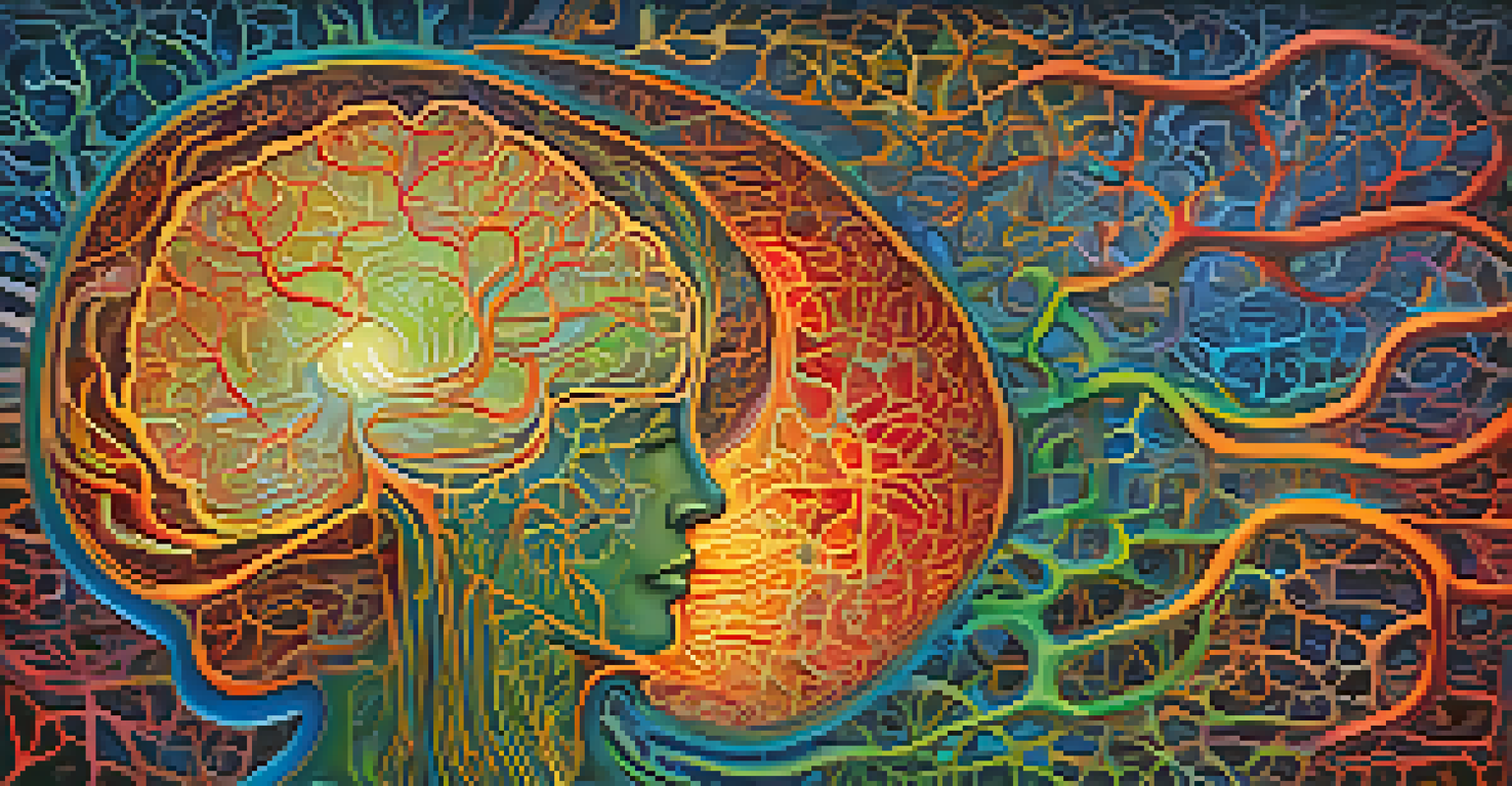Neurobiological Mechanisms of Ayahuasca on Mental Health

Understanding Ayahuasca: A Brief Overview
Ayahuasca is a traditional South American brew made from the Banisteriopsis caapi vine and the Psychotria viridis leaf. This potent mix contains the hallucinogenic compound DMT, known for its mind-altering effects. Used for centuries in shamanic rituals, ayahuasca is now gaining attention in the realm of mental health. Its potential therapeutic benefits are particularly relevant in a world increasingly focused on holistic healing methods.
The greatest medicine of all is to teach people how not to need it.
As interest in ayahuasca grows, so does the need to understand how it interacts with our brain. Research suggests that ayahuasca may influence various neurobiological mechanisms, which can have profound effects on mental well-being. This exploration bridges ancient wisdom with modern science, bringing new insights into mental health treatment.
Through this lens, we can appreciate the significance of ayahuasca not just as a psychoactive substance but as a potential tool for healing. It's important to approach this subject with an open mind, as we dive deeper into the neurobiological mechanisms involved.
The Role of DMT in Neurobiology
DMT, or dimethyltryptamine, is the primary psychoactive compound in ayahuasca. When ingested, it rapidly crosses the blood-brain barrier, affecting neurotransmitter systems in the brain. DMT is structurally similar to serotonin, a key player in mood regulation, which may explain its impact on mental health.

Studies have shown that DMT can promote neuroplasticity, the brain's ability to reorganize itself by forming new neural connections. This could be particularly beneficial for individuals struggling with conditions like depression or PTSD, as it may facilitate new ways of processing emotions and experiences. Imagine it as a fresh coat of paint on a wall, allowing for vibrant new colors and perspectives.
Ayahuasca's Healing Potential
Ayahuasca may serve as a therapeutic tool, offering insights into mental health treatment through its neurobiological effects.
Moreover, the experience induced by DMT often leads to introspection and emotional release, further contributing to its therapeutic potential. This unique interaction with our brain makes DMT a fascinating subject for researchers exploring innovative mental health treatments.
Neurotransmitter Systems and Ayahuasca
Ayahuasca affects various neurotransmitter systems, most notably serotonin and dopamine. Serotonin is crucial for mood regulation, while dopamine plays a critical role in the brain's reward system. By modulating these systems, ayahuasca may help alleviate symptoms of anxiety and depression.
Healing doesn’t mean the damage never existed. It means the damage no longer controls our lives.
For instance, many users report experiencing enhanced emotional clarity and a deeper connection to their feelings after an ayahuasca ceremony. This emotional catharsis can help individuals confront and process long-held traumas, paving the way for healing. It's akin to cleaning out a cluttered attic; once the mess is cleared, you can finally see the space for what it truly is.
Additionally, the interaction between these neurotransmitters and ayahuasca highlights the brew's potential to foster a sense of well-being and connection. This interplay may provide a pathway for individuals seeking relief from their mental health struggles.
The Impact on Brain Connectivity
Research indicates that ayahuasca can enhance connectivity between different regions of the brain. This increased connectivity may facilitate improved communication among neural networks, leading to more integrated thoughts and emotions. The experience can feel like tuning a radio to find the clearest signal, allowing for a more harmonious understanding of oneself.
For those dealing with mental health issues, such as depression or anxiety, this enhanced connectivity can be transformative. It may enable individuals to break free from rigid thought patterns that contribute to their conditions. By fostering a more flexible mindset, ayahuasca can support new perspectives and coping strategies.
DMT's Role in Neuroplasticity
The psychoactive compound DMT in ayahuasca promotes neuroplasticity, potentially aiding those with depression and PTSD.
This neurobiological effect highlights the potential of ayahuasca as a therapeutic tool, bridging the gap between mind and body. Such insights encourage further exploration into how these experiences can lead to lasting change in mental health.
Emotional Healing and Ayahuasca
One of the most profound aspects of ayahuasca is its ability to facilitate emotional healing. Many participants in ayahuasca ceremonies report intense emotional releases, often tied to past traumas or unresolved feelings. This process can be cathartic, allowing individuals to confront and process emotions that have been buried deep within.
Imagine carrying a heavy backpack filled with stones; each stone represents a past hurt or trauma. Ayahuasca can help you metaphorically unpack that backpack, lightening your emotional load. This release can lead to newfound clarity and peace, as participants often leave ceremonies with a sense of relief and renewed purpose.
Furthermore, the communal aspect of these ceremonies fosters a sense of connection and support, reinforcing the healing process. This shared experience can be incredibly powerful, enabling individuals to feel less isolated in their struggles.
Potential Risks and Considerations
While ayahuasca shows promise for mental health treatment, it's essential to approach it with caution. Not everyone may respond positively to the brew, and there are potential risks involved, especially for individuals with certain medical conditions or those on specific medications. Consulting with a healthcare provider before participating in an ayahuasca ceremony is crucial.
Additionally, the setting in which ayahuasca is consumed can significantly impact the experience. Participating in a poorly facilitated ceremony can lead to negative outcomes, reinforcing the importance of choosing reputable, experienced guides. It's vital to prioritize safety and well-being throughout this journey.
Risks of Ayahuasca Use
While promising, ayahuasca carries risks that necessitate careful consideration and consultation with healthcare providers.
Ultimately, while ayahuasca may offer transformative experiences for many, it is not a one-size-fits-all solution. Recognizing the potential risks helps ensure that individuals make informed decisions about their mental health.
The Future of Ayahuasca in Mental Health Treatment
As research into the neurobiological mechanisms of ayahuasca continues to grow, so does its potential role in mental health treatment. With more studies emerging, we may soon see ayahuasca integrated into therapeutic practices for various conditions. This shift could pave the way for a more holistic approach to mental health care.
Imagine a future where traditional healing practices, like ayahuasca ceremonies, complement conventional therapies. This integration could provide individuals with diverse tools and resources to address their mental health challenges. It reflects a broader movement toward recognizing the value of alternative modalities in modern medicine.

In conclusion, the exploration of ayahuasca's neurobiological effects on mental health opens up exciting possibilities. As we continue to learn from both ancient traditions and modern science, we can better understand how to support individuals on their healing journeys.